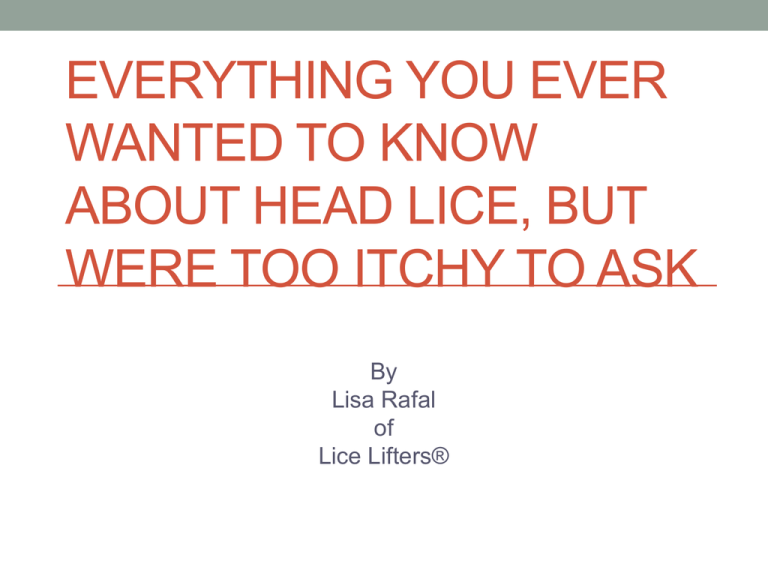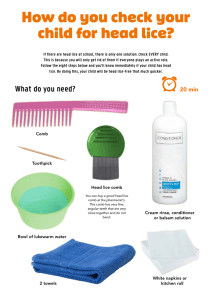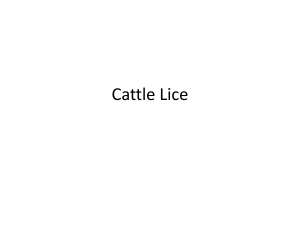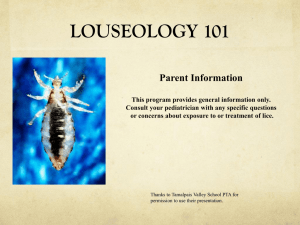Everything You Ever Wanted to Know About Head Lice, But Were
advertisement

EVERYTHING YOU EVER WANTED TO KNOW ABOUT HEAD LICE, BUT WERE TOO ITCHY TO ASK By Lisa Rafal of Lice Lifters® What Are Lice? Human head lice (Pediculus humanus capitis) are parasitic wingless insects that make their home on the human head. They feed on human blood and lay their eggs (nits) on human hair. The warmth and moisture on our heads provides the perfect environment for them. When a person has lice, it is referred to as an infestation. The formal medical term is “Pediculosis.” How do we get head lice? • Over 90% of cases are passed on by direct head to head contact with an infested individual • Sharing of personal items (i.e. hair brushes, hats, batting or bike helmets, hair accessories, dress up clothes, etc.) with someone who has head lice is the second most common way to transfer lice between hosts • Environmental transfer, which is picking up a bug from furniture or a seat back in a movie theater or airplane, accounts for no more than 2% of cases How Do I Know if Someone in My Family Has Lice? • While not everyone will be itchy from head lice, if you have a child who seems to be scratching his/her head significantly, it may be an indication that lice are present • The presence of nits (eggs) in the hair is definitive evidence of head lice infestation • In more severe cases, you may begin notice small bites on your child’s neck or scalp, similar to mosquito bites but smaller • It is rare to see live bugs in the early stages of infestation, but as activity increases on the head, you may see bugs in the hair. If you see something move on the child’s head but then don’t see anything, it could be a head louse. They move from the light very quickly to avoid detection What do head lice and their eggs(nits) look like? On the left is a male and on the right is a female louse. Females are larger than males. Lice have 2 body segments and six legs in addition to 2 antennae located at the tops of their heads. How to Find Nits Nits may be found all over the head, but the “hot spots” tend to be the crown, behind the ears, the nape of the neck and in the bangs. Nits are glued securely to the hair shaft. When looking at the hair, if you see something you suspect may be a nit, if you brush at it with your hand and it moves, it is NOT a nit. When removed from the hair, nits are typically a greyish-brown color, but can range in color from cream to dark brown and look like tiny sesame seeds How to Do a Thorough Home Head Check • Wet the hair • If the hair is long enough, divide into sections: for girls divide the hair down the middle of the head and then further divide each half of the head into 3 or 4 sections, depending on how thick the hair is. Use clips or ponytail holders to hold the sections that aren’t being combed • Use a good quality stainless steel nit comb to comb through each section. The combing should be done from the top, bottom, right and left (N,S,E & W). Make sure to drag the comb directly down the scalp and pull the comb straight through the hair to the ends • Wipe the comb on a white paper towel and examine anything you remove from the hair What do I do if I find lice or nits on my child? • The most important thing is not to panic. Lice, while a major • • • • annoyance, are not a threat to your child’s health or well-being. Head lice infestation can be devastating to a child’s self-esteem, and a parental response can either soothe this or exacerbate it. Remain calm, you will get through this! Explore your treatment options Every member of your family should be checked for lice INFORM YOUR FRIENDS, FAMILY and SCHOOL NURSE! If your child has lice they got it from someone and have likely passed it on to someone else as well. If you do not inform your circles (friends, playdates, extracurricular activities, etc.) the likelihood that you will become re-infested from someone is greater. You should go back 2-3 weeks to anyone with whom your child/family has had close contact to report the problem. In particular, children in whose homes your child has been and who have been in your home. Act in a timely manner. Unlike some things, this problem never improves with time. Non-Toxic Treatment Options • Head lice can be treated at home with the right tools and a commitment of time and effort. Success depends on removing ALL nits and live bugs from the hair. • Professional Nitpickers • The FDA-cleared LouseBuster™ • Kills over 99% of nits • Approved for use in children 4 and over • Non-toxic over the counter products are another aid in treating head lice infestation. There are currently products available (The Nit Nanny, LiceMD) that work to eliminate live activity, however they do not kill or remove nits from the hair. Using these products alone does not eliminate an infestation. Other Treatment Options • Over-the-Counter Pesticides • Rid contains Pyrethrins with piperonyl butoxide • Nix contains Permethrin • Prescriptions • Kwell (Lindane)—Carcinogenic, Banned in CA • Ulesfia (Benzyl Alcohol)– Can be uncomfortable with irritated scalp, alcohol is systemically absorbed • Ovide (Malathion)—partially ovicidal, treatment takes 8-12 hours • Natroba (Spinosad & Benzyl Alcohol)— partially ovidicidal, causes lice to shake until they die of paralysis, alcohol is systemically absorbed • Sklice (Ivermectin)—an antiparastic which is partially ovicidal and can interact with some other medications, traditionally used for ringworm and scabies All of these treatments contain toxic chemicals. With the exception of Natroba and Malathion, they do not kill nits (eggs). Additionally, many of these options are not successful with only one treatment which means that success depends on retreating and repeatedly exposing your family to applications of toxic substances on the sensitive skin of the scalp. Prevention Tips • Girls’ hair should be pulled back, in braids or a bun when possible. • • • • • • • Loose flying hair comes in contact with other heads more easily. Boys’ hair should be kept trimmed, when feasible. Children should be instructed to limit head to head contact with other children. Advise your children not to share personal items with other children, i.e. brushes, combs, hats, hair accessories, helmets, etc. Keep hair care items separate for every member of the family. Use plastic shoe boxes, ziploc bags, separate drawers in the bathroom, to maintain separate brushes, combs, hair accessories, etc. Brush or comb hair daily. Lice do not like to be disturbed. While not a guarantee, use of a repellent can be helpful. Look for a product with peppermint (The Nit Nanny Mint Spray) or citronella (FairyTales Rosemary Repel Spray). Always look for a leave-in product, do not invest money in a product that gets rinsed out of the hair. It can’t repel lice when it’s in your drain! Most important…INFORM YOUR FRIENDS WHEN YOU’VE HAD LICE! If you don’t you are far more likely to be re-infested. Well, I heard that… • Getting lice means you’re dirty • Using a lot of hair gel means you won’t get lice • You can get nits without a bug • African-Americans can’t get lice • My dog/cat can get lice • I need to throw out my pillows, brushes, hair accessories if we get lice in our house • Lice spread diseases • Lice can fly and jump Fact VS Fiction • Getting lice means you’re dirty NO! Lice prefer clean hair. Dirty, oily hair does not offer the best environment in which to lay their eggs. Although lice are survivors and will go anywhere there is a head for them! • Using a lot of hair gel means you won’t get lice NO! While having less fly away hair may make it less likely that lice will get a “leg up” into your child’s head, gel and hairspray alone do not create a deterrent. • You can get nits without a bug NO! Nits, once removed from the hair CANNOT reattach to another hair on the same head, nor can they attach to another head. • African-Americans can’t get lice NO! While it’s true that lice don’t prefer the shape of African American hair, ethnicity of ANY kind is not a guarantee of anything. Fact VS Fiction • My dog/cat can get lice • NO! They are HUMAN HEAD LICE. Regardless of what kind • • • • • • of dog/cat you have, unless it is part human, it is not a suitable host for a human head louse. I need to throw out my pillows, brushes, hair accessories if we get lice in our house NO! It is possible to adequately clean or isolate everything in your home after an infestation. The tendency to go on a mass purge only adds to the financial cost of the infestation. Lice spread diseases NO! They are certainly unpleasant, but ultimately harmless. Lice can fly and jump NO! They are wingless insects, and while they can crawl up to 9” a minute, they do not jump or fly. Conclusion Head lice infestation causes the loss of tens of millions of school and work days for millions of families across the US every year. The two largest issues with head lice infestation are 1) Parents feeling ashamed or intimidated and therefore not reporting cases 2) Inadequate treatment leading to ongoing infestation. We can all acknowledge that having bugs on our children or ourselves is unpleasant, but how we react to this issue determines how our children and our friends react to it. One of the most important things we can do is work to eliminate the stigma associated with head lice. By eliminating the negative associations people carry with respect to lice, we can increase reporting, more effectively identify outbreaks and help children through this problem without impacting their self esteem. Q&A What are your specific questions about head lice?






